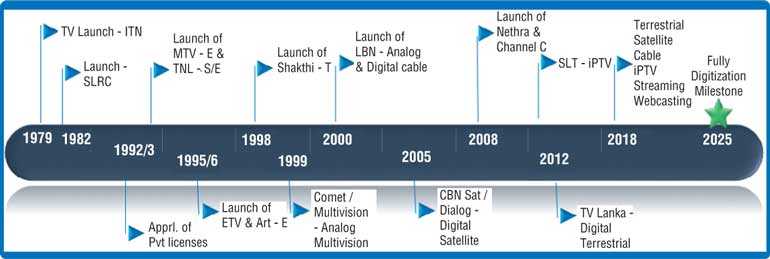Sunday Apr 20, 2025
Sunday Apr 20, 2025
Friday, 25 May 2018 00:00 - - {{hitsCtrl.values.hits}}

 After nearly four decades of introduction of TV in Sri Lanka we still continue to enjoy watching free TV frequencies, compared to our other South Asian counterparts, where Pay TV has become a bigger norm and way of life.
After nearly four decades of introduction of TV in Sri Lanka we still continue to enjoy watching free TV frequencies, compared to our other South Asian counterparts, where Pay TV has become a bigger norm and way of life.
There are many advantages as well as many disadvantages in both these forms of so called medium of edutainment.
One can argue that Free TV would be more unbiased, authenticated, truthful and so on; however there is a cost attached to developing the content and broadcasting it, so the investor behind it is looking for some means of return on investment and not only for the ‘fame’ he or she gains by owning it. The main revenue streams are advertising, sponsorships and content re-broadcasting. With growing competition in there are many other ways of brand communications which are mushrooming.
Therefore in order to be competitive the broadcasters have few choices, either to reduce unit cost of advertising or to disproportionately increase the quantity of advertisements/sponsorships or to compromise on the quality of the content. All these factors will definitely drive away the audiences to other mediums.
There emerges the Pay TV concept – you practically pay only for whatever you prefer, when, where and how long you want to watch. Some also give you a glimpse of what to expect and Pay-as-You go, isn’t it cool?, so from the broadcaster’s point of view with the right kind of pre promotion the risk is minimised and content developed based on the current and anticipated future trends of the audiences. This phenomenon creates a win-win situation for advertisers/ brands/sponsors/broadcasters/producers who could co-create edutainment platforms that suit your intended audiences.
In Sri Lanka Pay TV is taking it slow pace, in the year 2016 Free TV to Pay TV audience ratio stands at 82:18, in absolute terms Pay TV audiences increased by 772k or by 26% whereas Free TV audiences declined by 2% when compared to the year 2015. There are many factors which contributes to this, firstly Sri Lanka had been a predominantly Free TV market, since the first TV launch in 1979 controlled by the government and it took another 15 years to allow the private sector to open up and another 20 years to provide Pay TV licenses. During the first 15 years government milked the advertising industry through managing a duopoly market, where demand over tookthe supply, with advance payment terms, not adhering to a fixed point chart, political agenda taking precedence over marketing and no clear vision of what so ever to counter future technical and marketing challenges.
‘There is a Bright Spot in the every Dark Cloud’ as quoted by Bruce Beresford.
As all we Sri Lankans believe Pay TV will overcome its challenges with –the right product, at the right price, at the right place with the right promotion and combine many other nuggets in order to thrive in the future. We all look forwardtowards an entrepreneur who would like to take this as a positive challenge!
About the author : Rohith Hettiaratchi, is a seasoned veteran in the field of Communication & Advertising counting over 25 years of experience in the Advertising agencies, Client organisations across South Asian markets. Author could be contacted on email [email protected]
Discover Kapruka, the leading online shopping platform in Sri Lanka, where you can conveniently send Gifts and Flowers to your loved ones for any event including Valentine ’s Day. Explore a wide range of popular Shopping Categories on Kapruka, including Toys, Groceries, Electronics, Birthday Cakes, Fruits, Chocolates, Flower Bouquets, Clothing, Watches, Lingerie, Gift Sets and Jewellery. Also if you’re interested in selling with Kapruka, Partner Central by Kapruka is the best solution to start with. Moreover, through Kapruka Global Shop, you can also enjoy the convenience of purchasing products from renowned platforms like Amazon and eBay and have them delivered to Sri Lanka.
Discover Kapruka, the leading online shopping platform in Sri Lanka, where you can conveniently send Gifts and Flowers to your loved ones for any event including Valentine ’s Day. Explore a wide range of popular Shopping Categories on Kapruka, including Toys, Groceries, Electronics, Birthday Cakes, Fruits, Chocolates, Flower Bouquets, Clothing, Watches, Lingerie, Gift Sets and Jewellery. Also if you’re interested in selling with Kapruka, Partner Central by Kapruka is the best solution to start with. Moreover, through Kapruka Global Shop, you can also enjoy the convenience of purchasing products from renowned platforms like Amazon and eBay and have them delivered to Sri Lanka.